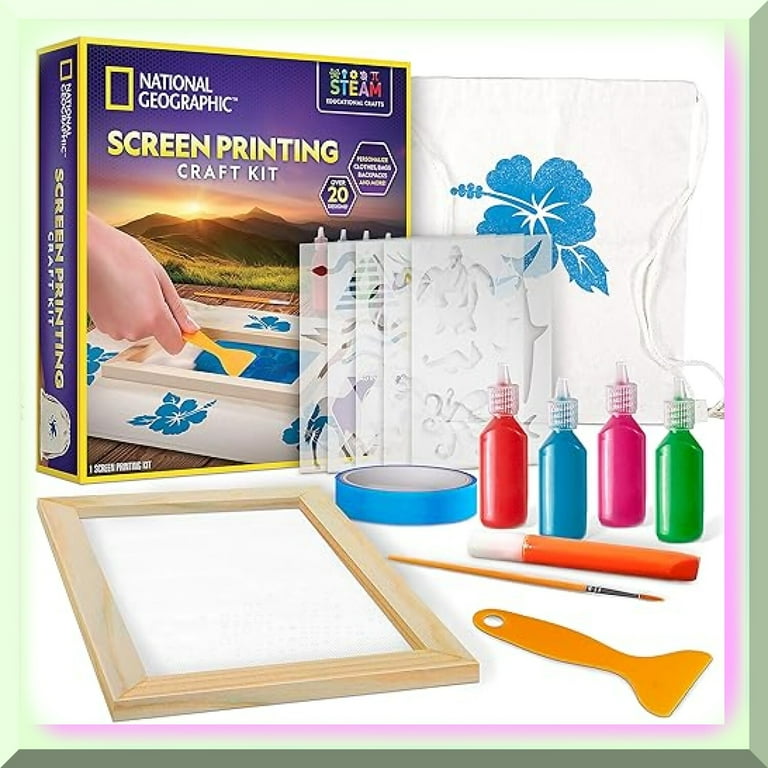Premium Screen Printing Kit for Business Startups
Premium Screen Printing Kit for Business Startups
Blog Article
Display Printing Uncovered: Everything You Required to Understand About Tee and Garment Printing Methods
If you have actually ever before asked yourself just how those dynamic layouts end up on your favorite t-shirts, you're in the right area. Display printing is a fascinating technique that integrates art with method, using limitless possibilities for imagination. Understanding the fundamentals, from equipment to ink options, can substantially affect your results. Ready to explore the necessary aspects that make display publishing an art kind? Let's reveal the information that can elevate your jobs.
The Fundamentals of Display Printing: Exactly How It Functions
When you dive right into display printing, you'll find it's both an art and a science. At its core, display printing entails creating a pattern, or display, that permits ink to pass via just in particular areas (screen printing kit). You start by selecting your style and preparing your display with a light-sensitive emulsion. As soon as you expose this solution to light, it solidifies, leaving your design as an adverse area.
Position the screen over the textile, then use a squeegee to press ink with the screen onto the garment. Each action is essential, and understanding them will certainly elevate your screen printing skills, transforming easy garments into unique, meaningful items.
Types of Screen Printing Methods
As soon as you comprehend the basics of display printing, it's time to explore the various techniques that can raise your designs. One popular approach is typical display printing, where ink is pushed via a stenciled screen.
Another option is plastisol printing, recognized for its durability and brilliant shades, making it a favorite for several brand names. Experiment with halftone printing to develop gradient impacts and intricate layouts.
Important Devices for Screen Printing
To achieve sensational results in screen printing, having the ideal devices is essential. You'll require a tough screen printing frame, which holds the mesh that transfers your style onto the garment. Next off, spend in premium mops; these are important for applying ink equally across the screen.
Choosing the Right Inks and Products
When picking inks and products for display printing, you require to consider the kind of ink that functions ideal for your job. Consider fabric compatibility to ensure your designs look last and fantastic long. Check out environment-friendly ink alternatives to make your printing process extra sustainable.
Types of Screen Inks
Picking the right display ink is vital for accomplishing dynamic, long lasting prints that satisfy your project's requirements. There are several types of screen inks to analyze. Plastisol ink is popular for its versatility and convenience of use, giving excellent color opacity on dark fabrics. Water-based ink, on the various other hand, offers a softer feel and is environment-friendly, making it excellent for those aiming to reduce their environmental effect. Release inks remove dye from the fabric, causing a soft, classic look however call for details handling. Lastly, specialized inks, such as metal or glow-in-the-dark, can add one-of-a-kind effects to your styles. Examine your job requirements and select the ink that lines up finest with your desired outcome.

Fabric Compatibility Considerations
Comprehending material compatibility is essential for accomplishing high-grade display prints, specifically considering that various products respond distinctively to different inks. Constantly check your inks on example fabric to assure they stick appropriately and preserve color integrity. Furthermore, keep in mind that textile weight and structure can affect the last result, so picking the appropriate ink and product combination is essential for your job's success.
Eco-Friendly Ink Options
Green inks are ending up being a preferred selection for display printers that want to minimize their ecological effect while keeping top quality. When selecting inks, take into consideration water-based inks, which are less hazardous and easier to clean up contrasted to standard solvents.
Furthermore, look for inks made from renewable resources, such as soy or vegetable-based choices. By picking the appropriate inks and materials, you'll not only produce magnificent styles yet also contribute to a much more sustainable printing procedure. Make the button, and your prints will certainly reflect your dedication to the setting!
Preparing Your Layout for Display Printing

Submit Layout Needs
To guarantee your layout looks vivid and sharp on textile, you'll need to pay attention to file style demands for additional info display printing. Begin with vector data like AI or EPS, as they can be scaled without shedding high quality. If you use raster pictures, select high-resolution data, such as TIFF or PNG, ideally at 300 DPI. Avoid utilizing JPEGs, as they can shed clearness when resized. Make certain your design has a clear background to avoid undesirable white sides on your prints. Ultimately, maintain color settings in mind; CMYK is typical for screen printing, so transform your RGB develops as necessary. By complying with these guidelines, you'll establish your artwork up for an effective print.
Shade Splitting Up Techniques
Color splitting up is a vital action in preparing your design for display printing, and understanding it can greatly enhance your print top quality. You'll need to damage your style right into individual colors, as each shade calls for a separate display during printing. Beginning by recognizing all the shades in your layout and develop layers for each one. You can make use of software application like Adobe Photoshop or Illustrator to separate and different shades efficiently. Be particular to save each layer as a different file, generally in a layout like TIFF or PSD. This accuracy not just ensures accurate color representation however likewise streamlines the printing process. By taking notice of color splitting up, you'll achieve expert and vibrant results in your screen-printed garments.
Resolution and Dimension
Attaining the finest lead to screen printing begins with assuring your layout has the appropriate resolution and dimension. Ideally, your artwork should go to least 300 DPI (dots per inch) for sharp, clear prints. If you utilize reduced resolution, your final item may look pixelated and amateur.
When it pertains to size, take into consideration the dimensions of your print area. Design your artwork to match the final print size, ideally creating it in the real measurements you'll be publishing. In this manner, you'll prevent any type of unexpected scaling problems.
Always examine your style in both vector and raster formats. Vector graphics can be internet scaled without shedding top quality, making them perfect for screen printing. Preparing appropriately will assure your layout looks fantastic on every garment!
Step-by-Step Display Printing Process
Screen printing is a dynamic process that enables you to create vivid styles on various surfaces. To begin, you'll require a display, solution, and your selected ink. Initially, prepare your screen by cleansing it extensively. Next off, use the emulsion evenly and let it completely dry in a dark location. When dry, reveal your display to light with your layout positioned on it, which will set the solution where the light hits, producing a pattern - screen printing kit.
Pour ink onto the display and use a squeegee to push the ink via the pattern onto the material. Raise the screen meticulously and allow the print dry. You've efficiently display published your design.
Tips for Effective Screen Printing Projects
While you're diving into your display printing projects, keep in mind that prep work is vital to success. Beginning by collecting all your products-- inks, garments, mops, and screens. A tidy work space assists protect against unwanted mistakes, so clean up before you start.
Following, verify your artwork is high-resolution and effectively sized for your garment. Check your display for appropriate direct exposure and tidy it completely to stay clear of smudges. When mixing your inks, follow the supplier's standards to attain the right consistency.
During printing, use even stress with your squeegee for consistent outcomes. Do not hurry; take your time to verify each print satisfies your requirements. After printing, let your garments dry completely prior to taking care of or packaging them.
Lastly, always keep an example of your benefit future referral. In this manner, you can analyze your progress and boost your techniques over time. Satisfied printing!

Often Asked Inquiries
The length of time Does It Take to Establish a Screen Printing Job?
Establishing a screen printing work normally takes around half an hour to an hour. You'll prepare the displays, mix inks, and change the press. The time varies based on complexity and experience, so stay organized!
Can I Publish on Different Textile Types Making Use Of the Very Same Technique?
Yes, you can publish on different material kinds using the very same method, but you'll require to change your setups and inks. Some fabrics soak up ink in a different way, so trying Recommended Reading out assurances the most effective outcomes for every product.
What Are Usual Mistakes to Prevent in Screen Printing?
When display printing, stay clear of common blunders like utilizing the incorrect ink, ignoring correct exposure times, or skipping pre-press checks. Always test your configuration and preserve tidy screens to ensure top quality outcomes each time.
How Can I Properly Tidy and Keep My Display Printing Tools?
To correctly clean and preserve your display printing tools, you must frequently clean screens with appropriate solvents, inspect mops for wear, and guarantee all devices are kept completely dry and dust-free. Uniformity improves and prevents pricey repair services efficiency.
Is Display Printing Eco-friendly Contrasted to Various Other Methods?
Display printing can be more eco-friendly than various other approaches, particularly if you use eco-conscious materials and water-based inks. By selecting sustainable products and techniques, you minimize waste and minimize your impact on the world.
Screen Printing Uncovered: Every Little Thing You Required to Know About Tee Shirt and Garment Printing Techniques
At its core, display printing includes producing a stencil, or screen, that enables ink to pass with just in details locations. Position the display over the textile, after that make use of a squeegee to press ink with the display onto the garment. One preferred technique is conventional display printing, where ink is pressed via a stenciled screen.When choosing inks and materials for display printing, you need to take into account the kind of ink that works ideal for your project.
Report this page